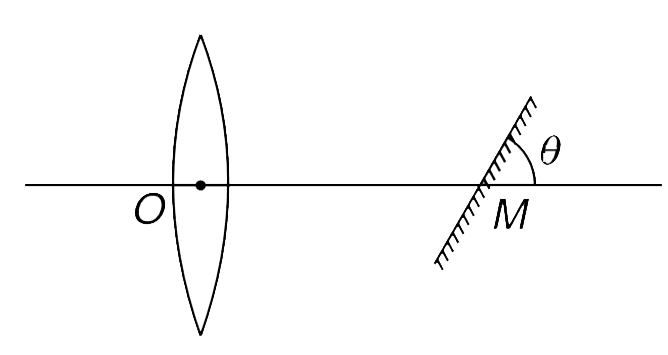A convergent beam of light passes through a diverging lens of focal length 0.2m and comes to focus at a distance of 0.3m behind the lens. Find the position of the point at which the beam would converge in the absence of the lens.
Here, f=−0.2m,v=+0.3m
from lens equation
1v−1u=1f
1u=1v−1f=10.3−1−0.2=253
u=325=0.12m
Therefore, in the absence of lens, the beam would coverge at a distance of 0.12m to the right of the concave lens.
Topper's Solved these Questions
- RAY OPTICSBOOK - PRADEEPCHAPTER - RAY OPTICSEXERCISE - Solved Example(c )
21 Videos
- RAY OPTICSBOOK - PRADEEPCHAPTER - RAY OPTICSEXERCISE - Solved Example(d)
32 Videos
- RAY OPTICSBOOK - PRADEEPCHAPTER - RAY OPTICSEXERCISE - Sample problem(d)
5 Videos
- PROPERTIES OF BULK MATTERBOOK - PRADEEPCHAPTER - PROPERTIES OF BULK MATTEREXERCISE - Multiple choice questions
7 Videos
- SYSTEMS OF PARTICLES AND ROTATIONAL MOTIONBOOK - PRADEEPCHAPTER - SYSTEMS OF PARTICLES AND ROTATIONAL MOTIONEXERCISE - Assertion- Reason Type questions
20 Videos
Similar Questions
A convergent beam of light passes through a diverging lens of focal length 0.2m and comes to focus at a distance of 0.3m behind the lens. Find the position of the point at which the beam would converge in the absence of the lens.
View SolutionA converging beam of light is incident on a concave lens of focal length 20 cm. In the absence of the lens, the beam converges at a point 10 m behind the lens. Find where the beam will converge/diverge after refraction.
View Solution
Knowledge Check
If a convergent beam of light passes through a diverging lens, the result
AMay be a convergent beamBMay be a divergent beamCMay be a parallel beamDMust be a parallel beamIf a convergent beam of light passes through a diverging lens, the result
AMay be a convergent beamBMay be a divergent beamCMay be a parallel beamDMust be a parallel beamIf a convergent beam of light passes through a diverging lens, the result
Amay be a convergent beamBmay be a divergent beamCmay be a parallel beamDmust be a parallel beam
A beam of light converges at a point P. A concave lens of focal length 16 cm is placed in the path of this beam 12 cm from P. Draw a ray diagram and find the location of the point at which the beam would now converge.
View SolutionA diverging lens has a focal length of 0.10m. The power of this lens will be:
View SolutionA converging lens of focal length 5.0cm is placed in contact
with a diverging lens of focal length 10.0cm. Find the combined focal length of
the system.
View SolutionA horizontal parallel beam of light passes though a vertical convex lens of focal length 40 cm. Behind the lens there is a plane mirror making an angle θ with the principal axis of the lens. The mirror intersects the principal axis at M. Distance between the optical centre of the lens and point M is OM=20cm. The light beam reflected by the mirror converges at a point P. Distance OP is 20 cm. Find θ.

View SolutionConvergent beam of light is passed through a diverging lens. Light rays after passing lens
View Solution
